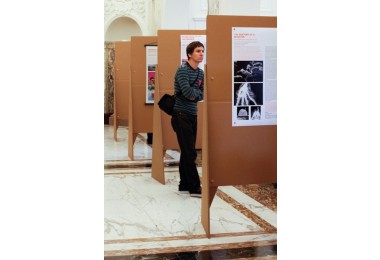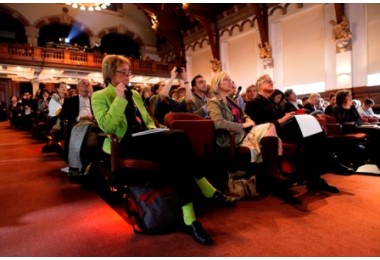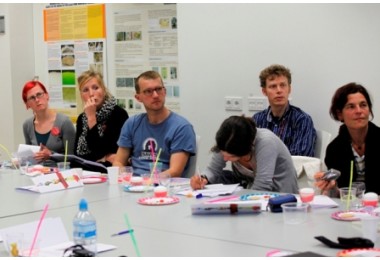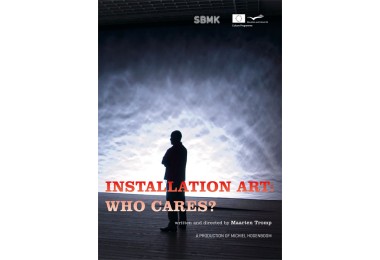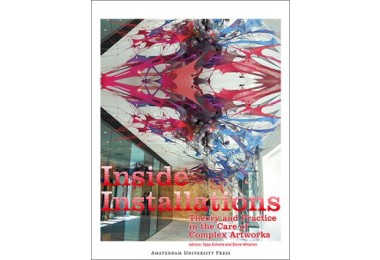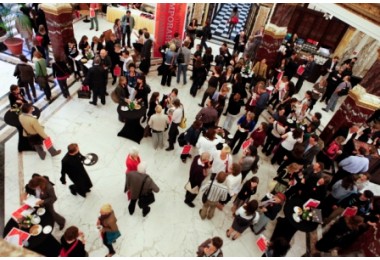-
Next >
The Research Agenda 2008-2012 includes five research programmes focussing on collection-management. Their binding factor is ‘valuation’.

-
Program
Value and valuation
Development of methods and techniques to objectify the value and appreciation of cultural heritage.
more info >Under 'valuation' in relation to heritage we mean making substantiated and verifiable statements about the value of an object or a collection, based on a question falling under an appropriate frame of reference and concerning certain stakeholders. Predetermined and predefined criteria are applied.
This explicit defining of an assigned value is necessary to steer preservation, development and utilisation and to enable a societal basis for heritage to emerge. After all, who determines the value of the collection now that the 'expert' no longer counts as the sole authority? How do you valuate an object or collection if there is no objective measurable value? How do you provide sufficient societal support for heritage at a time when the cultural sector is under pressure?
Awareness
The Value and Valuation programme aimed to make the various players in the heritage field (owners, managers, policy makers and funders) aware of the importance of the intrinsic (non-financial) value and valuation of cultural heritage, and to develop methods and techniques to attribute value to objects and collections. As valuation benefits from a broad interdisciplinary approach, the emphasis lay on dialogue and collaboration with external partners. A new system was developed in close consultation with the museum world to facilitate the process of value attribution. This has resulted in the publication of On the museum scales: collection valuation in six steps.
Independent valuation
This practical guide takes the user through the valuation process step-by-step and results in a description of object/collection significance, a valuation ranking or grouping, or an investment plan. With well-founded arguments it is possible to explain to others the value of an object or collection and the reasons for the value. This facilitates decision-making on interventions, making conflicting interests negotiable and making stories behind the collection accessible.
-
Program
Collection Accessibility
Research into the effectiveness of methods and means to make heritage and related knowledge accessible online.
more info >New media forms a tempting alternative to traditional analogue guides for the public as staff and resources in museums are generally scarce. But do they function as well or better than gallery texts, guided or audio tours?
Are some applications more effective than others? Are there any applications that actually generate more visitors, and if so, which?
Effectiveness
The Accessibility programme focused on the effectiveness of virtual resources to make heritage visible and to interest new types of public. Possibilities include apps, 3D and AR techniques, and also social media like Facebook and YouTube. But what to choose from the overwhelming number of new techniques?
Insight
The RCE carried out an inventory to provide collection managers with an understanding of the developments and possibilities of new media (and the institutions that can assist in developing applications). This also aimed to chart the applications most effective for specific objectives for both content and generating visitors. The projects on which these questions were tested were diverse in nature:
- Conservation of two textile objects of polypropylene. In this project, the practical applicability of conservation knowledge about polypropylene was tested. In addition a conservation treatment of polypropylene was recorded for educational objectives and the conservation file placed online. As a result, both the object and the information are permanently accessible for consultation by collection managers and conservators.
- Imago revisited: research into two installations in a case study using good practice (developed during the Inside Installations project) regarding the daily and long-term management of complex (multimedia) installations.
- Generating and sharing knowledge online about the conservation of contemporary art in the two-year European project PRACTICs by museums, institutes and universities. Associated with this was a public testing of the film Installation Art: Who Cares? as an educational tool, to investigate how much visitors appreciated having a look 'behind the scenes'.
- CARTA project, an inventory of documentation projects and documentation systems with which research findings are linked to locations and artworks.
- Inventory of the operation of two thematic networks (INCCA Education and Postdoc Network) under INCCA.
- Archiving the website with all details of the Inside Installations project, the preservation and presentation of Installation Art Project (2004-2007), a research into the re-installation and documentation of 33 complex multimedia installations.
- Participation of the RCE as a research partner in the pilot project of MuseumApp, under which the effectiveness of this app for heritage institutions was studied.
- Development of guidelines to increase the effectiveness of museum institutions online.
-

-
Project
Development of the website 'From Research to Restoration' (R2R) intended to help prevent the rapid degradation of polypropylene objects.

-
Project
Evaluation of the function of two thematic networks under the INCCA platform.

-
Project
Improving guidelines for the re-installation and long-term preservation of multimedia art.

-

-
Project
How to get in touch with a new online heritage audience - a guide.

-

-
Project
A guide for measuring the effectiveness of apps and websites.

-
Project
Generating and sharing knowledge about the conservation of contemporary art by museums, institutions and universities.
Reading modeshareApril 30th 2011 marked the end of PRACTICs; a European project for interdisciplinary collaborative research, sharing knowledge and learning about the conservation of contemporary art. 33 leading museums, institutions and universities joined hands for two years to assess and implement knowledge gained through European projects of the last decade.

Contemporary Art: Who Cares? (I do!)
The many challenges entailed in the conservation of contemporary art have led to a great diversity of knowledge and experience in conservation practice. The PRACTICs project aimed to collect, compile, share and supplement with case studies, knowledge on the most urgent issues: installation art, documentation, decision-making, artist participation, research and education.
Collaboration
The project was organized by the RCE in collaboration with six European organizations: Tate Modern in England, Restaurierungszentrum Düsseldorf and Cologne University of Applied Sciences in Germany; the Museo Nacional Centro de Arte Reina Sofia in Spain, the Museum of Contemporary Art (SMAK) in Belgium and the Conservation Foundation for Contemporary Art (SMBK) in the Netherlands. A few years earlier this group had successfully collaborated on the Inside Installations project (2004-2007). The project was funded by the Culture Programme (2007-2013) of the European Commission and the Mondriaan Fund.
Installation Art: Who Cares?
Installation Art: Who Cares? is a 25-minute documentary that offers a peek behind the scenes of European museums, revealing the problems museum professionals face in the conservation and exhibition of installation art. The content of the documentary gave rise to a number of public meetings where the museum public's reactions to the documentary were used to judge whether the documentary form is the most suitable means to convey such information.
Results
The main results of the PRACTICs project:
- Contemporary Art: Who Cares?, an international symposium held in 2010 at the Royal Tropical Institute in Amsterdam?
- The book, Inside Installations: Theory and Practice in the Care of Complex Artworks (ed. Tatja Scholte and Glenn Wharton);
- The documentary, Installation Art: Who Cares?;
- 2 Access2CA seminars (Ljubljana 2009 and Porto 2011);
- 2 new INCCA groups: INCCA Central and Eastern Europe and INCCA Education Network.
Publications
Scholte, T. en G. Wharton, Inside Installations: Theory and Practics in the Care of Complex Artworks, Amsterdam University Press, 2011.
Links
PRACTICs (website)
Documentaire Installation Art: Who Cares?
De evaluatie van de documentaire Installation Art: Who Cares?
Inside Installations (gearchiveerde website)
Projectmanager
Karen te Brake-Baldock
Team member
Tatja Scholte
Partners
Universiteit van Amsterdam (Sanneke Stigter); INCCA North America (Glenn Wharton); Getty Conservation Institute, Los Angeles (Tom Learner); Museo del Novecento, Milaan (Marina Pugliese); TateModern, Engeland (Pip Laurenson); Statens Museum for Kunst, Kopenhagen (Louise Cone); Restaurierungszentrum Düsseldorf (RZ, Cornelia Weyer), Fachhochschule Köln (Gunnar Heydenreich); Akademie der bildenden Künste Wien (Martina Pfenninger); Art-documentation, Bonn (Ulrike Baumgart); Hamburger Kunsthalle (Barbara Sommermeyer); Museum Jean Tinguely, Bazel (Reinhard Bek); Pinakothek der Moderne, Doerner Institut, München (Maike Grun); Zentrum für Kunst und Medien ZKM, Karslruhe (Frederika Wagner); Thomas Zirlewagen (freelance conservator); Estonian Art Museum, Tallinn (Hilkka Hiiop); Stedelijk Museum voor Aktuele Kunst S.M.A.K., Gent (Frederika Huys, Katrien Blanchaert); Academy of Fine Arts, Faculty of Conservation, Warchau (Iwona Szmelter, Monika Jadzinska); Stichting Behoud Moderne Kunst SBMK, Den Bosch (Paulien ’t Hoen); Bonnefantenmuseum, Maastricht (Ingrid Kentgens); Kröller-Müller Museum, Otterlo (Sanneke Stigter); Museum Boijmans van Beuningen, Rotterdam (Jaap Guldemond), Nederlands Instituut voor Mediakunst NIMk, Amsterdam (Gaby Wijers); Stedelijk Museum Amsterdam (Nicole Delissen, Marlous van Gastel); Van Abbemuseum, Eindhoven (Christiane Berndes); Museum of Modern Art, Rijeka, Kroatië (Duska Cikovic); Museo Nacional Centro de Art Reina Sofia MNCARS, Madrid (Jorge Garcia, Arianne Vanrell, Mayte Ortega); Centro Arte Contemporaneo Andaluz CAAC, Sevilla (Jose Carlos Roldan); Instituto Valenciano de Arte Moderno IVAM, Valencia (Maite Martinez); Museu d’Art Contemporani de Barcelona MACBA (Silvia Noguer); Universidade do Porto, Faculty of Arts (Lucia Matos); Moderna Glerija, Ljubljana, Slovenië (Mojca Stuhec)

-
Project
Evaluation of the documentary Installation Art: Who Cares? as information medium.

-
Project
Inventory of documentation systems to link research results to locations on artworks.

-
Program
Object in context
Enrichment of the object in its context on the basis of technical art history and research, for the benefit of its conservation and restoration.
more info >Objects that have been handed down to us from the past can tell a story of their history of creation and how they have changed over time.
The Object in Context programme makes such stories accessible through research on the material object and its contextual clues (historical evidence). In addition, the program focuses on questions concerning the restoration and conservation of a range of objects, from classical antiquity to contemporary art, from paintings and textiles to metal and plastics.
CSI
Under Object in Context, analytical chemistry researchers and forensic specialists delve into cause and effect. Besides a keen eye for detail, they employ a research laboratory and technological methods that enable the visualization of evidence visible only at a molecular level. Although analytical research often forms the basis for research, collaboration with other disciplines, such as art and cultural history, is always sought as well.
Arts meets sciences
A connecting link between the many projects under Object in Context is the extent to which ageing is regarded as acceptable. That limit of acceptance is subjective and cannot be considered purely from the material-technical perspective. Thus the theme of 'perception of the surface' is key in several projects. This involves coupling the scientific 'looking' through apparatus with subjective, human visual perception.
Download here the comprehensive introduction to the Object in Context program, including an introduction to the projects in PDF.
-
Program
Museometry
Quantitative research on composition, use and policies concerning museum collections.
more info >In the museum sector, procedures and processes of collection management are analysed using figures and indicators to only a limited extent. As a result, decisions are often based on impressions or tradition.
Ad hoc quantitative analyses have been performed in recent years. Again and again it has proved difficult to generate reliable figures.
Structural
When comparing museums it was also revealed that the number of variables arising form an almost insurmountable barrier for benchmarking. The RCE therefore opted for a structural, long-term program with the focus on a statistical approach to research questions concerning collection management.
EBM
Under the Museometry programme, quantitative research is conducted on the composition, use and exploitation of museum collections. Trends and developments are distilled from the collected facts and figures on museum collections (museometry). The resulting figures and analyses are made available for the museum professionals and managers responsible for museum collections. In turn, they use this quantitative data for the formulation of various policies concerning these collections. In this way museometry contributes to evidence-based management (EBM) in the museum sector.
Projects
Projects under this program include:
- The Loan Monitor: a website that visualises on a map loan movements between national and international museums for exhibitions.
- The Modern Art Collection Audit (CMBK), a statistical analysis of how Netherlands museums have collected modern art from 1999 to 2009. The database, comprising acquisition data from about 40 museums with relevant collections of modern art, makes statistically based statements possible about the collection policy of the museums.
- The 20th century Artist Index, in which major artists are inventoried from the period 1870 to the present.
- Completion and verification of available data on international collection mobility, accessibility and cultural participation arising from the implementation of the indemnity scheme.
- An inventory and analysis of museum annual reports.
-
Program
Collection Risk Management
A user-friendly method for heritage managers to assess and manage risks themselves.
more info >The Collection risk management (CRM) program is aimed at minimizing the loss of value at the interface between preservation and use. The existing CRM methodology has been tested in different situations, developed and simplified in order to bring it within reach of smaller institutions with limited time and resources.
To this end, new instruments were developed and information necessary to quantify the various risks was generated and made available in the convenient form of a digital manual. The program concluded with an international meeting on risk management.
CRM
Risk management examines all the threats to which collections are exposed and combines preventive conservation, security and facility management. This forms the next step in the professionalization of collection preservation and management. In applying this strategy, the risks for a collection are identified, analysed and evaluated. These risks can then be compared on the basis of the expected value loss over a given period (risk assessment) and ranged to set priorities for measures to reduce this loss of value. This aids the collection manager in making informed and substantiated choices in the deployment of the often limited resources available to collection management.
Methodology
Under the CRM program, the methodology was tested in case studies, courses and workshops, then further developed and simplified so that smaller institutions with limited time, resources and knowledge can also gain insight into their own situation. To this end knowledge must be generated to qualify or quantify the various risks and ultimately made available in a usable form. This process was carried out in a number of projects under the program. Knowledge development and deployment of the indemnity scheme also fell under this program. The field of security risks and calamities was covered in collaboration with the Safe Heritage programme.
Handbook
The before-mentioned knowledge and instruments are for the most part collated in the Digital Collection Risk Management Manual. This describes the methodology step-by-step, provides instruments for conducting a risk analysis and sets out the available information on the ten most important damage factors. In this way, the user is able to carry out a risk analysis with their team. The Manual helps in formulating the right questions for external experts.
Risk analysis
Two projects under the program were intended to generate data to aid in assessing risk scenarios and to determine extent of risk. On the one hand quantitative information was collected for events that could lead to loss of value (damage factors of fire, theft and vandalism, mechanical forces and water), and on the other, degradation processes (damage factors of climate, light, mechanical forces vibration and air pollution/dust). In addition, a model was developed under the Cost Effectiveness project for determining the cost-effectiveness of conservation measures.
Research on Paper
Finally the Metamorfoze project (National Programme for the Conservation of Paper Heritage) sought solutions for the preservation and treatment of original paper documents. The research focused on inherent deterioration such as ink corrosion, the usefulness (or uselessness) of air purification in depots and the development of a portable instrument for the on-the-spot determination of light sensitivity of objects.
The CRM programme concluded in 2012 with the meeting Reducing Risks to Heritage in collaboration with ICCROM and CCI.


